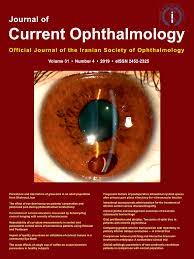Prevalence and risk factors of glaucoma in an adult population from Shahroud, Iran
Authors
Affiliations
1Noor Research Center for Ophthalmic Epidemiology, Noor Eye Hospital, Tehran, Iran.
2Noor Ophthalmology Research Center, Noor Eye Hospital, Tehran, Iran.
3Farabi Eye Hospital, School of Medicine, Tehran University of Medical Sciences, Tehran, Iran.
4Department of Medical Surgical Nursing, School of Nursing and Midwifery, Shahid Beheshti University of Medical Sciences, Tehran, Iran.
5Center for Health Related Social and Behavioral Sciences Research, Shahroud University of Medical Sciences, Shahroud, Iran.
6Department of Community Medicine, School of Medicine, Tehran University of Medical Sciences, Tehran, Iran.
7Department of Epidemiology and Biostatistics, School of Public Health, Tehran University of Medical Sciences, Tehran, Iran.
Abstract
Purpose: To determine the prevalence of glaucoma and its risk factors in a 40- to 64-year-old Iranian population.
Methods: In this cross-sectional study, 6311 individuals between the ages of 40-64 years old in Shahroud, a northeastern city in Iran, were selected through multistage cluster sampling. All participants underwent eye exams, optometry, and imaging. They had stereoscopic optic disc photography, visual field evaluation, and their intraocular pressure (IOP) was measured by ophthalmologists before pupil dilation. Glaucoma was defined by the standardized criteria, offered by the International Society for Geographical and Epidemiological Ophthalmology (ISGEO).
Results: Of the 5190 people who participated in the study (82.2%), data from 4637 people were used in the analysis. The prevalence of glaucoma was 1.92% [95% confidence intervals (CI): 1.53-2.31]; 1.4% (95% CI: 0.96-1.84) in women and 2.62% (95% CI: 1.95-3.28) in men. Glaucoma prevalence was 0.9% in the 40-44 years age group, and significantly increased to 3.55% in the 60-64 years age group. In the multiple logistic regression model, age [odds ratio (OR) = 1.08, 95% CI: 1.05-1.12], IOP (OR = 1.04, 95% CI: 1.01-1.06), axial length (OR = 1.34, 95% CI: 1.1-1.63), corneal radius of curvature (OR = 2.76, 95% CI: 1.26-6.06), and corneal diameter (OR = 0.63, 95% CI: 0.46-0.87) showed significant statistical association with glaucoma.
Conclusions: The prevalence of glaucoma was considerably high at older ages. Major risk factors confirmed by this study included older age and high IOP. Certain ocular biometric components such as the axial length and the corneal radius of curvature must be noted as important glaucoma risk factors at younger ages.
Keywords: Cross-sectional study; Glaucoma; Iran; Prevalence.

